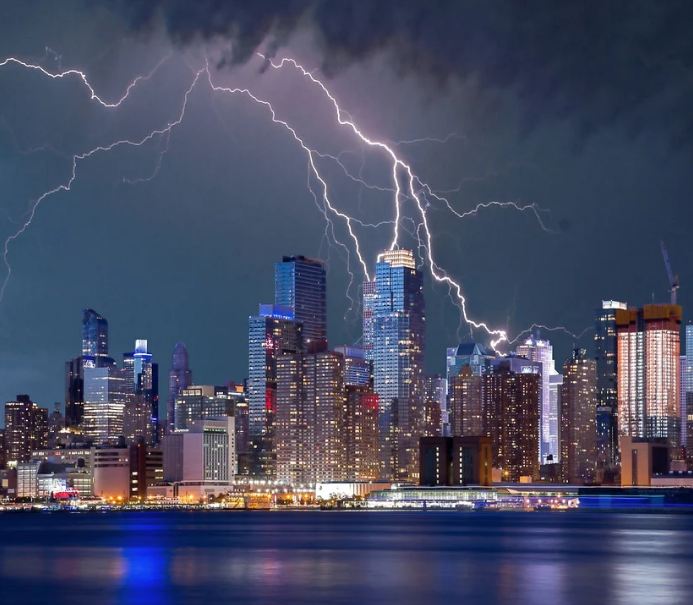Lightning is the sudden discharge of the electrostatic force during an electrical storm. During this discharge, the atmosphere’s charged regions equalize themselves temporarily right as they hit an object on the ground. There will always be the sound of thunder accompanying the lightning.
How does lightning form?
Since lightning is an electric current, to produce it, a cloud must also be present. Hot ground heats the air above it, which then rises. Water vapor cools as the warm air rises and then forms a cloud. The cloud becomes massive as the air rises. The top of the clouds’ temperature is below freezing, which turns the water vapor into ice. This forms a thundercloud. Now, as a significant number of small ice bits collide with each other while moving around, it causes a build-up of electrical charge.
The build-up fills the clouds with an electrical charge, and the positively charged particles form at the top of the cloud since they’re lighter while the negatively charged particles, which are heavier, sink to the bottom of the cloud. Lightning occurs when both the positive and negative charges in the clouds grow large enough and create an electrostatic discharge channel that travels downwards in long distances.
Although lightning mostly happens inside a cloud, there are times when it happens from the ground up to the cloud.
This happens when the ground right underneath the cloud has a positive charge build-up and becomes attracted to the negative charge, which is at the bottom of the cloud. The positive charge from the ground focuses on anything that sticks up, like trees or lightning conductors. Positive charge from the ground and negative charge from the clouds connect and form a spark of lightning.
What is Catumbo lightning?
Lightning never strikes the same place twice, or does it? Just right over the Catatumbo River in Venezuela, where the river empties into Lake Maracaibo, thousands of lightning strikes every hour.
This phenomenon is known as Catatumbo lightning or the Beacon of Maracaibo. Some even call it the “everlasting storm.” It was named because, in the area where the Catatumbo River meets Lake Maracaibo, an average of 260 storm days annually occur.
For nine hours, the night sky in this area is frequently illuminated with thousands of lightning flashes.
The Catatumbo lightning, or in Relámpago del Catatumbo in Spanish, occurs from the masses of storm clouds with more than 1 km in height, and that happens as frequently as 140 to 160 nights a year. In a day, it occurs about 280 times per hour in a 10-hour duration. Venezuela earned a record from the Guinness Book of World Records for having the “highest concentration of lightning” with annual lightning flashes of 250 per square kilometer. In the dry months of January and February, the storms ease off and peak around October, the wet season.
The lightning’s frequency is inconsistent throughout the year. The frequency usually differs from year to year. From January to March of the year 2010, the lightning flashes ceased to occur, and drought was the apparent reason. As a result, speculations about it being permanently extinguished were made.
The lightning phenomenon usually develops between the coordinates 8°30′N 71°0′W and 9°45′N 73°0′W. One theory about the storms was that they resulted from winds blowing across Lake Maracaibo and the swampy plains surrounding it. Along the high mountain ridges of the Andes, Mérida’s Cordillera, and the Perijá Mountains, air masses enclose the plain from three sides. And as the mountain ridges weaken the air masses, the plains’ heat and moisture create electrical charges, which makes thunderstorm activity. The lightning that occurs during this phenomenon produces a large ozone quantity, but it doesn’t affect the ozonosphere since it’s unstable.
Experts have looked for reasons for the occurring phenomenon in the area for decades. One theory in the 1960s was that it was due to the uranium deposits in the bedrock that attracted more lightning strikes. Scientists suggested more recently, the air’s conductivity was magnified by the amplitude of methane from oil fields below it. Neither of these two theories was proven, so for now, the acceptable reason for this phenomenon is credited to the area’s topography and wind patterns.
The Catatumbo lightning is so bright that it can be seen from 400 km or 250 miles away. It was said that colonial sailors used it to navigate. There were claims that the lightning strikes are multi-colored, but some eye-witness said it was just a trick of the light. The multi-colored lightning strikes might be because portions of the white light are absorbed while passing through dust or moisture; some might also be diffracted. This makes it appear a different color.


